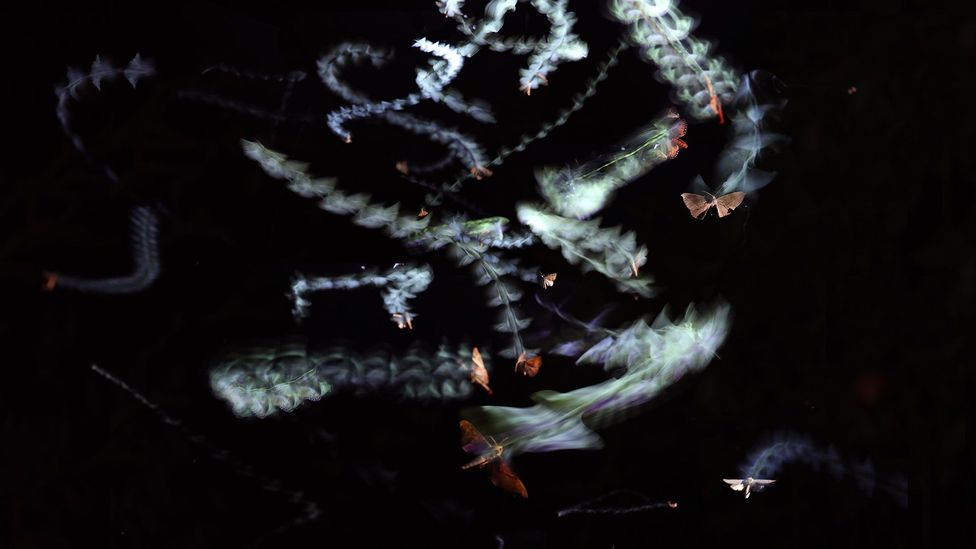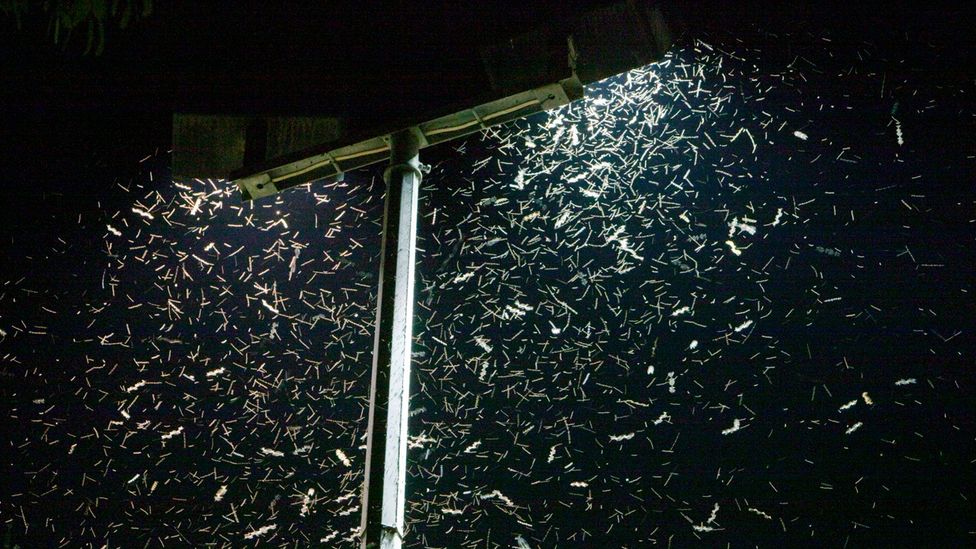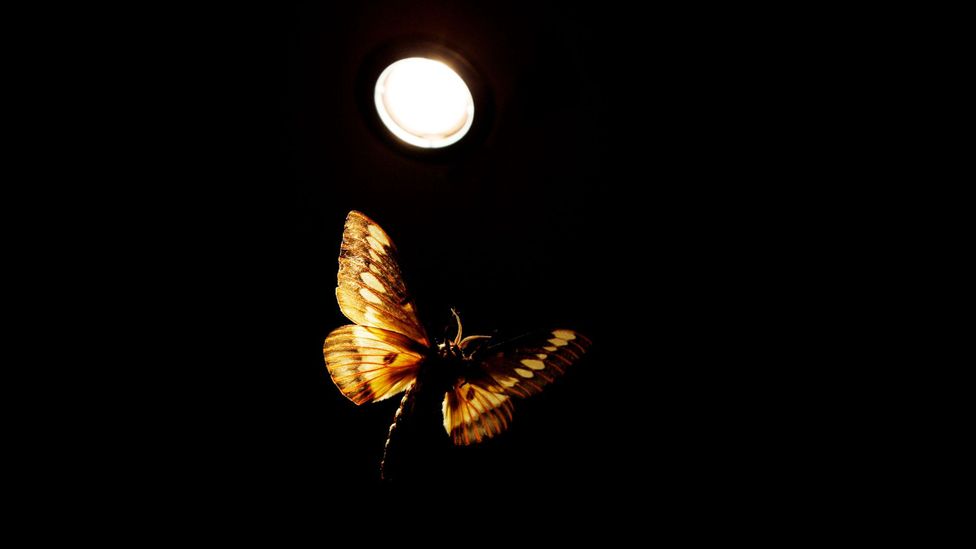High up in the mountains of Monteverde, Costa Rica, a team of researchers lug heavy equipment including two high-speed cameras deep into a dream-like cloud forest. As the cool mist rolls in along with the darkness of twilight, they set up a light source and cameras a few metres away, then power up their computers, sync them to the cameras and wait, letting their eyes adjust.
The team in Costa Rica spent several weeks huddled under a tarp in thick jumpers, getting bitten by mosquitoes and horseflies all in the name of answering a question that's eluded science for hundreds of years – why do insects flock to light at night?
Some scientists believed they were simply attracted to the light source. Others thought it might be the warmth of the light pulling them in. Even more felt they were mistaking artificial light for the light of the sky which they use to navigate. The unusual flight patterns the field researchers observed, however, pointed to a different hypothesis: the insects are trapped by artificial light because they think it will help stabilise them.
Sign up to Future Earth
Sign up to the Future Earth newsletter to get essential climate news and hopeful developments in your inbox every Tuesday from Carl Nasman. This email is currently available to non-UK readers. In the UK? Sign up for newsletters here.
The scientists from Imperial College London and Florida International University used motion-sensor cameras which allowed them to see how the insects were traveling in 3D space. This revealed a strange behaviour: the insects appeared trapped in orbit around the light source with their backs to it. This is called a dorsal light response – where animals keep their top side, or back, facing the brightest object in their range of vision. Since insects are too lightweight to use ground reaction forces (the force exerted by the ground on a body) to orient themselves in space as humans do, and are often in flight, they need to rely on a different stable source to know which way is up. At night, that used to be the moon and stars – until humans invented artificial light.
"The insects treat a point light source at night very much in the same way as they would treat the sky during the day. And so the sky, no matter where you are, is always overhead," says Samuel Fabian, co-author of the study and a postdoctoral research associate in bioengineering at Imperial College London.

Motion-sensor cameras revealed that the insects appeared trapped in orbit around the light source with their backs to it (Credit: Samuel Fabian)
A point light source, such as a lamp, however, forces insects to keep reorienting to face away from it and continue to curve around it in an endless loop. Think of it like a plane when it tilts to turn — the force of the forward acceleration and lift of the plane creates a curving motion. So what normally helps keep insects aligned with the horizon ends up turning them on their heads, literally.
Fabian participated in both the field study in Costa Rica with his research partner Yash Sondhi, a postdoctoral research associate in entomology at the University of Florida, and the lab study. The lab study was conducted similarly but in a large flight arena with eight high-speed, infrared cameras. Rather than just observe insects' behaviour in their natural habitat, he could essentially turn the smaller bugs into data points by putting 1mm markers on their backs.
"Since the cameras have strobe lights that are firing at the same time as they're taking pictures, the tiny little markers [become] bright spots for the camera," says Fabian. This allows the cameras to then send what they read as data points straight to the computer, leading to what Fabian calls "crazy levels of accuracy".
You might also like:
- Squirrel and Japanese knotweed: pests on the menu
- The US is bracing itself for a cicada mega swarm
- Could grasshoppers replace beef?
Despite the discrepancies in methodology, the researchers saw the same sort of behaviour over and over again, across dozens of different types of insects, from dragonflies to fruit flies. The back-facing orbiting seems to disprove previous theories on why insects congregate by artificial light at night (ALAN), even one of the most popular theories – that insects were mistaking ALAN for the moon, which scientists argue they use as a sort of compass.
"The way you navigate by the moon is it's so far away that when you walk, the moon just appears to hover in the sky for you and so it's a good indication of whether you've turned or not, especially for flying," says Jamie Theobald, a co-author of the recent study and associate professor of biological sciences at Florida International University.
This theory, however, doesn't explain all the peculiar patterns the researchers observed during their field and lab work. Aside from orbiting, Fabian says they witnessed stalling (where an insect appears to fly straight up around the side of the light, then loses momentum and falls back down as if it were a pendulum), and flying directly over the light while inverted.
That last behaviour is why Fabian and Sondhi consider flood lights to be the worst light pollution offenders – the beams of light that fill a large area cause insects to flip upside down abruptly, leading to a lot of catastrophic crash landings. (Read more about how light pollution affects plants' senses).

Light pollution can confuse insects and divert them from mating, pollinating and evading predators (Credit: Getty Images)
ALAN is bad for insects across the board; it diverts them from the activities that keep them healthy and alive – pollinating or eating, mating, and evading predators. "Artificial light can also confuse an insect's sense of time and make it difficult to know where they are within a day or a year, which has all sorts of ramifications for activity and development, respectively," says Avalon Owens, an entomologist and research fellow at the Rowland Institute at Harvard University.
A review of 229 studies on light pollution found that ALAN is a major driver of insect population loss. And, as light pollution continues to grow in tandem with ever-expanding urbanisation (about 10% annually), increasing losses will follow. This could severely impact crops that rely on insects for pollination, hobbling food supplies for larger animals, including humans.
Fabian, Sondhi and Owens stress that there is a simple solution, however: use less ALAN. Or, if you must use it, avoid flood lights, use LEDs on warmer settings, and put lights on timers. Sondhi also points to a soon-to-be-published German study that showed shielding or shrouding lights, which minimise glare by shining downwards, "helped reduce insect catch around the light by [about] 70 to 80%".
Several cities around the world are already taking steps to reduce their ALAN. Middletown, Ohio is converting thousands of street lamp lights to LEDs which can be programmed to cast warmer light. Nineteen other states have laws in place to reduce or shield ALAN, and several countries in the EU have implemented similar, nationwide laws.
The next chapter of this work for Fabian and Sondhi will involve testing the parameters of how far this light effect goes; does it pull insects from kilometres away, or just metres? "I don't think anyone has explained this satisfactorily to date – which is exciting because there is still much to be learned on this topic," says Owens.
"The direction of light is really important," says Fabian. "If we don't want to influence large amounts of insect populations, we should not have lights shining up into the sky."
--
If you liked this story, sign up for The Essential List newsletter – a handpicked selection of features, videos and can't-miss news delivered to your inbox every Friday.
Join one million Future fans by liking us on Facebook, or follow us on Twitter or Instagram.
